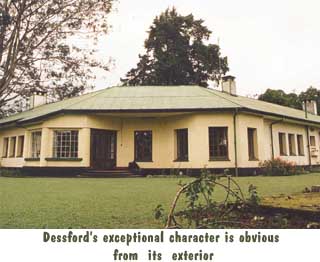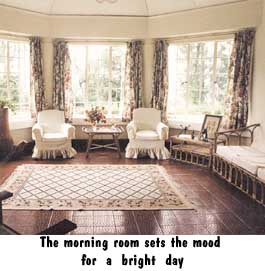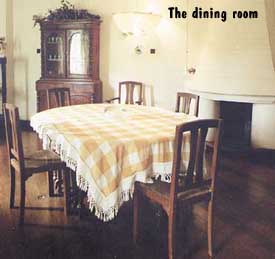

![]()
There is no doubt that Dessford has char- acter.
Its entrance at the crook of the el- bow of its L-shape layout suggests
a bungalow of unusual design. Its lines have the maturity of a bungalow
built at the beginning of the century. But what's this?  Modern
aluminium window frames by Crittal among the teak?
Modern
aluminium window frames by Crittal among the teak?
One of the stones in a flight of granite steps in the garden bears a date: 1885. This is also the date of the building of the railway station at Nanu Oya, four miles from Dessford. So is that when the bungalow was built? Perhaps. Fortunately some plantation records remain and record that additions were made to the original bungalow in 1939 changing its simple L-shape to a U.
You can see some of the changes from the garden where the sitting room with its encased Doric columns has a different style to the rest of the house. The garden is another of those hill country locations for a swimming pool. Like many pools to be found in the grounds of plantation bungalows, this one is abandoned, a symbol of the time when planters lived to the beat of a different drum.
Entry to Dessford is from the courtyard formed by its two wings. One
wing is given over to the servants' quarters, including the kitchen. This
is at the end of the long corridor running the breadth of the house, giving
access to the bedrooms of the other  wing,
and to the reception rooms.
wing,
and to the reception rooms.
The star feature of the bungalow is the morning room, part of the l939 addition. It has a tiled floor while the rest of the house is heavy with boards. Encased columns are to be seen inside the house as well as outside and frame those aluminium windows that give a view of the garden. The room is bright and simply furnished, contrasting with the comfort of the adjoining sitting room.
That is part of the original house with a wooden board floor to prove
it. An intriguing piece of furniture is the wooden drinks trolley, probably
locally made. It has an inspired design with four poles as narrow as broomsticks,
for its handle, and holes for  bottles
set into a shelf at the other end of its top. One wonders how such a spindly-looking
object has trundled across the boards and survived the demands of thirsty
planters over the years.
bottles
set into a shelf at the other end of its top. One wonders how such a spindly-looking
object has trundled across the boards and survived the demands of thirsty
planters over the years.
Michael Cooke, that Kandy-based inveterate investigator of plantation bungalows, has pointed out that few of the rooms at Dessford are completely square or rectangular. They all have curves in them somewhere. This is certainly true of the dining room. Centrepiece is the unusual oast-house design of the fireplace, with its diamond-sided conical flue. The room's uncarpeted board floor adds a spartan air which the fire, if ever it is lit, would surely evaporate.
There are fireplaces in the bedrooms and some solid pieces of teak furniture. A dressing table has a bold, circular mirror. In keeping with plantation tradition set by the need to cater for the Visiting Agent and planter colleagues the bedrooms are always ready for unexpected guests. The present occupants of Dessford have made good use of colourful fabrics to temper the bungalow's austere ambience. The sitting room of pink and purple, the yellow check table cloth in the dining room, and the pink rose hues of the guest bedroom show how an otherwise intimidating property can be tamed. And they add to Dessford's character.
Continue to Plus page 6 * All that Jazz
Return to the Plus contents page
![]()
| HOME PAGE | FRONT PAGE | EDITORIAL/OPINION | NEWS / COMMENT | BUSINESS
Please send your comments and suggestions on this web site to
info@suntimes.is.lk or to
webmaster@infolabs.is.lk